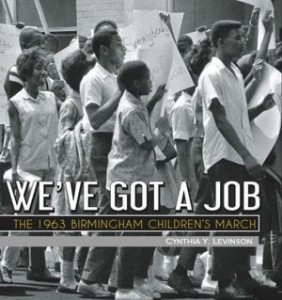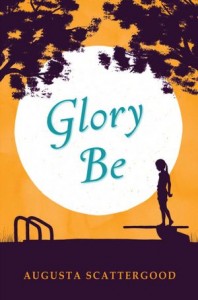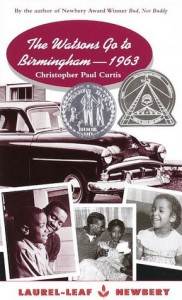I was alive during the Civil Rights struggles of the mid-50s and 60s, but wasn’t personally affected by them. So the history of those years can be a revelation, particularly in a recent nonfiction book for children:
*We’ve Got a Job: the 1963 Birmingham Children’s March, by Cynthia Levinson. Peachtree, 2012, 160 pages + 

1963 was a pivotal year, in good ways and bad. One of the good ways was the climax of the Civil Rights Movement in the August March on Washington and M.L. King’s “I have a dream” speech. But earlier that year came the Birmingham Children’s March, or Children’s Crusade, which gave the movement a much-needed victory at a crucial time. Birmingham was arguably the most segregated southern city, especially after doubling down on its Jim Crow laws in the fifties. Not only could blacks not drink from the same water fountains or swim in the same pools as whites, they couldn’t use common dressing rooms or restrooms. Mothers who took their children shopping were well-advised to carry along a jar with a tight-fitting lid for emergencies. The Reverend Fred Shuttesworth had had enough—he founded the Alabama Christian Movement for Human Rights (ACMHR) in 1956 to agitate for change through non-violent means. This was a strategy in accord with King’s Southern Christian Leadership Conference.
By 1963, sit-ins, freedom rides and Supreme Court decisions had produced some progress, but it was spotty and uneven. King and Shuttlesworth devised Project C (for “Confrontation”), a plan to fill all of Birmingham’s jails by forcing law-enforcement officers to arrest peaceful protesters, then using the publicity to highlight their “Points for Progress” regarding integration. But by May the plan was faltering: not enough people could participate because they feared repercussions or had to make a living (or both). That’s when the children (mostly teens) stepped in as protest volunteers: they had everything to gain and nothing to lose except a few days of school and some missed meals. But when Bull Connor’s notorious fire hoses started spraying and the dogs were set loose, these young people had to show extraordinary courage and restraint.
The story is told through the recollection of four black kids of varying age and social status: Audrey Henricks, a child of activists; James Stewart, a doctor’s son; Washington Booker III, a kid from the projects; and Arletta Streeter, a social butterfly turned social conscience. The author interviewed them, as well as some of their white counterparts, to come up with a compelling, personal narrative. What struck me was the Christian context—the black church’s involvement in the civil rights movement is well known, but I was not aware of the explicitly Christian message. The “10 Commandments of Non-Violence” that the kids were asked to abide by are stunning: “Meditate daily on the teachings and life of Jesus . . . Pray to be used of God in order that all men might be free . . . Love your enemies . . .” In four days almost 2500 young people had been arrested and the nation’s attention was riveted on Birmingham, to the latter’s great discomfort. President Kennedy (who is not romanticized in this account) was forced to take a stand, and the Birmingham civic leaders were shamed into shuffling down to path to integration. Though hurt remains, change was swift after that. Civil rights was an idea whose time had come, but it needed a push. “It was God’s time to make a change,” says Arletta Streeter; “I was blessed to be there.”
And I was blessed to read this book.
- Worldview/moral value: 5 (out of five)
- Literary value: 5
Glory Be, by Augusta Scattergood. Scholastic, 2012, 196 pages. Age/interest level: 10-13.


Glory is a mix of high spirits, sneakiness, and innocent screwups—and she can’t keep a secret, which will bring loads of trouble. She also get a little too emotional in a letter to the editor, which fortunately isn’t published (a worthwhile project might be to look it up on pages 126-29 and discuss what’s good and bad about it as an instrument of persuasion). Her faults are excused a little too easily, but her awakening to injustice and bigotry is realistic without getting too ugly, and it’s good to know that small southern towns were not 100% bigoted (pretty close, though). Glory loses some old friends while gaining appreciation for new ones. The pool stays closed but the library opens up—a better deal in the long run, because “books don’t care who read them.”
- Worldview/moral value: 3 (out of five)
- Literary value: 3
The Watsons Go to Birmingham – 1963, by Christopher Paul Curtis, Laurel Leaf (paperback edition), 2000,

About 14 years ago Christopher Paul Curtis, an auto worker in Flint, MI, quit his job to write this book. His wife went to work to support the family while he gave it his best shot, and it paid off. The Watsons, his first novel, won a Newbery honor that year and he followed up with more Newbery citations in subsequent years. The Watsons is already a classic of Civil Rights literature, and for all the elements of storytelling it’s hard to fault. To memorable, believable characters, emotional impact and a riveting plot, Curtis added his own brand of effortless humor that adds to the poignancy rather than detracting from it.
Kenny Watson, age 11, tells the story but the main character is arguably his older brother Byron, whose sassiness and waywardness convince Mr. and Mrs. Watson that he needs to spend a year in Alabama with his no-nonsense Grandma. Dad uses his vacation time to drive the whole family down for a visit in their old “Brown Bomber”—and, as the title indicates, they arrive just in time for the summer of ’63. The Children’s March has already happened, so we don’t hear much about that. Being down south at the height of the integration battles is an education in itself, culminating with the bombing of the 16th Street Baptist Church, which kills four young girls. Kenny’s little sister is in the church when it happens, leading to a frantic search for her and some soul-searching by her brothers.
The historical takeaways have less impact than the personal ones. Rather than “family values,” Mr. Curtis consistently highlights the value of family as a bond and a bulwark in the challenges of life. The Watsons, in spite of their bickering and fooling, are devoted to each other, and don’t need extraordinary powers to overcome.
Maybe there were magic powers hiding in the way your older brother made all the worst thugs in the neighborhood play basketball with you even though you double-dribbled every time they threw you the ball. And I’m sure there was an angel in Birmingham when Grandma Sands wrapped her little arms around all of the Weird Watsons and said, “My fambly, my beautiful, beautiful fambly.”
- Worldview/moral value: 3 (some mild profanity)
- Literary value: 4.5
?To go farther back in black history, check out our review of Heart and Soul.
Stay Up to Date!
Get the information you need to make wise choices about books for your children and teens.
Our weekly newsletter includes our latest reviews, related links from around the web, a featured book list, book trivia, and more. We never sell your information. You may unsubscribe at any time.
Support our writers and help keep Redeemed Reader ad-free by joining the Redeemed Reader Fellowship.
Stay Up to Date!
Get the information you need to make wise choices about books for your children and teens.
Our weekly newsletter includes our latest reviews, related links from around the web, a featured book list, book trivia, and more. We never sell your information. You may unsubscribe at any time.
FREE Bible Guide!
Get a guide to the Best Bibles for Children and Teens. Perfect for an Easter gift.
We'd love to hear from you!
Our comments are now limited to our members (both Silver and Golden Key). Members, you just need to log in with your normal log-in credentials!
Not a member yet? You can join the Silver Key ($2.99/month) for a free 2-week trial. Cancel at any time. Find out more about membership here.
5 Comments
Leave a Comment
You must be logged in to post a comment.


Thanks so much for the reviews, Janie. I had been wondering about a couple of these. I’m always so amazed when Christian ideas make into history books. I really think black Christians have an opportunity to witness to Him in unique ways considering the civil rights history. My concern when I heard rumblings about the children’s march, though, was whether it’s a good idea to ask children to do things like this that might be dangerous (i.e. an abortion march or occupy wall street march). I’d be interested in your thoughts about that.
I agree that it’s a bad idea to involve little children in political marches, because they don’t have a grasp of the issues involved and are exposed to possible danger (or at least bad sanitation!) purely on their parents’ initiative. But as I mentioned, the Birmingham children were mostly teenagers who had to deal with the effects of Jim Crow and segregation every day. (Audrey, age 9, was the youngest of the marchers.) They were fighting for their own future, and the organizers tried to prepare them for the risks. It turned out to be rougher for some of them than expected, but by and large it probably made them better adults.
I highly recommend the audio book of The Watsons, read by LeVar Burton! Thank you for the review of We’ve Got a Job. I look forward to reading it.
The Watsons Go to Birmingham is not well written, reflective of truth or inspiring. There is discussion of unclothed women on page 40 and disrespect of characters throughout the pages. I am surprised your review on this website is so generous.
I implore people to consider their walk with Christ and realize it doesn’t stop when you open a book.
Watsons go to Birmingham has use of middle finger, cursing, bullying, desecration of little brothers tooth brush, use of many racial slurs, drug references, and generally not responsible for personal actions.